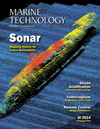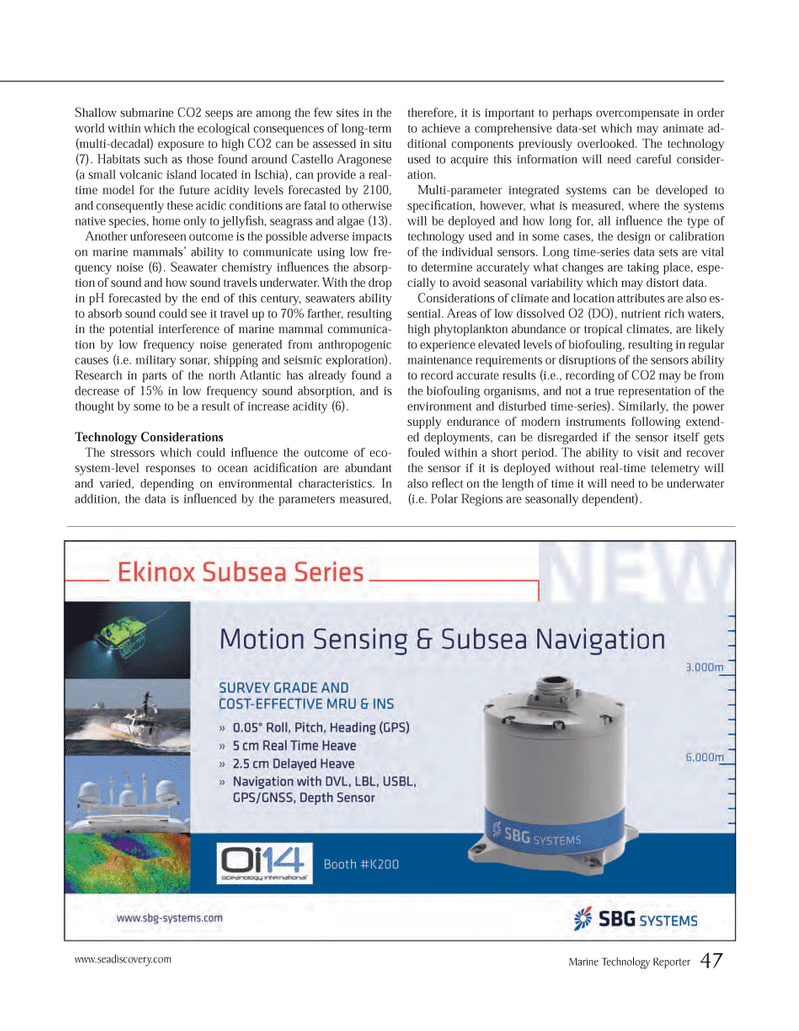
Page 47: of Marine Technology Magazine (March 2014)
Instrumentation: Measurement, Process & Analysis
Read this page in Pdf, Flash or Html5 edition of March 2014 Marine Technology Magazine
Shallow submarine CO2 seeps are among the few sites in the world within which the ecological consequences of long-term (multi-decadal) exposure to high CO2 can be assessed in situ (7). Habitats such as those found around Castello Aragonese (a small volcanic island located in Ischia), can provide a real- time model for the future acidity levels forecasted by 2100, and consequently these acidic conditions are fatal to otherwise native species, home only to jellyÞ sh, seagrass and algae (13). Another unforeseen outcome is the possible adverse impacts on marine mammalsÕ ability to communicate using low fre- quency noise (6). Seawater chemistry inß uences the absorp- tion of sound and how sound travels underwater. With the drop in pH forecasted by the end of this century, seawaters ability to absorb sound could see it travel up to 70% farther, resulting in the potential interference of marine mammal communica-tion by low frequency noise generated from anthropogenic causes (i.e. military sonar, shipping and seismic exploration). Research in parts of the north Atlantic has already found a decrease of 15% in low frequency sound absorption, and is thought by some to be a result of increase acidity (6). Technology Considerations The stressors which could inß uence the outcome of eco- system-level responses to ocean acidiÞ cation are abundant and varied, depending on environmental characteristics. In addition, the data is inß uenced by the parameters measured, therefore, it is important to perhaps overcompensate in order to achieve a comprehensive data-set which may animate ad- ditional components previously overlooked. The technology used to acquire this information will need careful consider- ation. Multi-parameter integrated systems can be developed to speciÞ cation, however, what is measured, where the systems will be deployed and how long for, all inß uence the type of technology used and in some cases, the design or calibration of the individual sensors. Long time-series data sets are vital to determine accurately what changes are taking place, espe-cially to avoid seasonal variability which may distort data. Considerations of climate and location attributes are also es- sential. Areas of low dissolved O2 (DO), nutrient rich waters, high phytoplankton abundance or tropical climates, are likely to experience elevated levels of biofouling, resulting in regular maintenance requirements or disruptions of the sensors ability to record accurate results (i.e., recording of CO2 may be from the biofouling organisms, and not a true representation of the environment and disturbed time-series). Similarly, the power supply endurance of modern instruments following extend- ed deployments, can be disregarded if the sensor itself gets fouled within a short period. The ability to visit and recover the sensor if it is deployed without real-time telemetry will also reß ect on the length of time it will need to be underwater (i.e. Polar Regions are seasonally dependent). www.seadiscovery.com Marine Technology Reporter 47MTR #2 (34-49).indd 47MTR #2 (34-49).indd 472/21/2014 11:14:12 AM2/21/2014 11:14:12 AM

 46
46

 48
48
